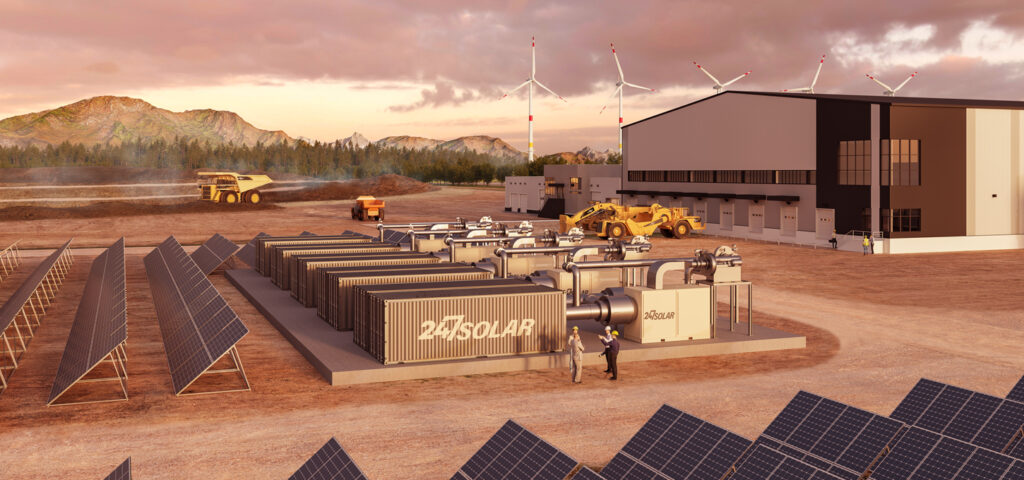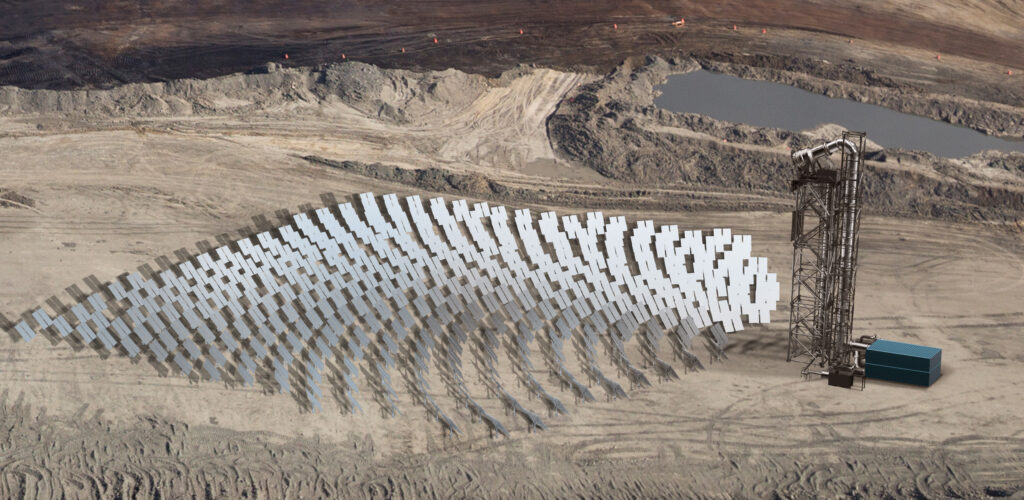ROADBLOCKS TO DECARBONIZING MINES – PROCESS HEAT
Guest article by Russell Blades
In this article, we will discuss an area of mining that has long frustrated many mine Energy Managers and Senior Management alike in their effort to totally decarbonize their mining operations – Process Heat.
The various mining processes that require thermal energy may include:
- calcining
- drying
- leaching
- roasting
- electrowinning
- refining
- steam production
The source of the process heat is typically from fossil fuels like coal, diesel, HFO, propane and natural gas. As a result, these thermal processes are a major additional source of GHG emissions (Figure 1) for mines to consider.
Figure 1: GHG Emission Factors For Various Fossil Fuels (source: EPA)
For example, a 150,000 tonnes/yr spodumene concentrate plant would require about 179,300 MMBtu/yr to dry their spodumene concentrate from 24% MC to 5% MC. If the mine is using diesel fuel for their rotary dryer, then the resulting annual GHG emissions would be about 13,500 tonnes CO2e. Even if the mine switched to natural gas, the GHG emissions would still be approximately 9,500 tonnes CO2e/yr.
The various thermal processes in the mining industry can be further divided by their operating temperatures into Low (<100°C), Medium (100°C – 600°C) and High (600°C – 2000°C)
Low Temperature Processes
Low temperature (<100°C) thermal process include heap leach heating for gold and copper ores, electrowinning and CIP/CIL for gold processing.
One option that mine’s are already implementing to reduce or eliminate their fossil fuel usage and associated GHG emissions, is the use of solar thermal energy with integrated energy storage.
For example, Codelco’s Gabriela Mistral mine in northern Chile utilizes a 38 MWth flat plate collector solar thermal plant with thermal storage (Figure 2) to help maintain an electrolyte temperature of 47°C for their electrowinning process.
The mine previously used diesel boilers to achieve these electrolyte temperature conditions.
The solar thermal plant (built, funded and operated by a third party – Innergex Renewable Energy Inc) helps to reduce the mine’s GHG emissions by 15,000 tCO2/yr and saves the mine about $2.0 million per year in energy costs.
Figure 2: Codelco’s Solar Thermal Plant with Energy Storage (source: International Mining)
Medium Temperature Processes
Dryers are a good example of a Medium Temperature (100°C – 600°C) mining process and are utilized for such operations as drying ore, concentrates (copper, zinc, lead, gold, silver, PGM, lithium, nickel, cobalt and manganese) and iron ore pellets.
The types of dryers that are being used in the mining industry include rotary (most common), flash, fluidized bed, belt and spray.
However, the one thing that they all have in common is that they typically operate on fossil fuels. As a result, they are another potential source of GHG emissions for the mining industry and a potential barrier to Net Zero targets.
Solar thermal plants with energy storage can provide the necessary energy and air temperatures that dryers need to remove the necessary moisture from the material being processed and generate no GHG emissions.
For example, 247Solar has developed a CSP technology with thermal storage that produces both renewable power and renewable process heat at 250°C discharged from their low temperature heat exchanger (HX).
This heated air, with no combustion byproducts, is an ideal source of renewable thermal energy for the various drying technologies and applications.
Figure 3: 247Solar’s Renewable Power & Process Heat with Energy Storage (source: 247Solar)
High Temperature Processes
High temperature (600°C – 2000°C) processes in mining include roasting, smelting, calcining, iron ore pelletizing, aluminum electrolysis, ferroalloy and silicon, and rare earth and lithium processing.
Figure 4: High Temperature Processes used in Mining
These high temperature processes are energy intensive and thus produce significant GHG emissions from the fossil fuels they consume.
As such, technology providers are developing CSP based technologies such as solar towers (800-1500°C) and solar furnaces(1500 – 2000°C) to help mining companies decarbonize these high temperature operations.
Other technology providers have taken a different approach by using electric heating from renewable resources to provide the necessary high temperatures for these various mining processes.
For instance, Calix has developed an electric calciner based on their core platform technology that can operate on renewable resources. Their electric calcining process also produces a clean CO2 stream, enabling efficient carbon capture and direct air capture solutions without additional chemicals or processes.
Figure 5; Calix’s Electric Calcining Technology with Carbon Capture (source: Calix)
GHG Emissions from Chemical Reactions
While on the subject of the various thermal processes used in mining, it is also important to note that the actual chemical reactions taking place during these processes can also produce GHG emissions.
Lime production is a good example. During the decomposition of limestone to lime in the calcining process, about 0.75 tCO2 are generated during the production of 1 tonne of lime.
Furthermore, the GHG emissions from the chemical reaction can far exceed the GHG emissions from the fuel that is used for the thermal process.
Thus, the mining industry along with other industries like steel production (blast furnace), aluminum production (Hall-Héroult Process), glass manufacturing, ammonia production and hydrogen production (Steam Methane Reforming) are also looking at ways to capture, sequester and even reuse the CO2 as feedstock for other processes (synthetic fuels).
Russell Blades, President, Energy & Mining Consulting
russ@energyandminingconsulting.com
A ROUND-THE-CLOCK CLEAN ALTERNATIVE TO FOSSIL FUELS
Achieving high levels of renewable energy is particularly challenging for off-grid mines in remote locations because intermittent PV or wind with costly batteries still require dirty, expensive diesel for backup. Many mines also require high-grade heat for on-site processing and other uses. 247Solar offers the only renewable energy technologies that:
- Integrate seamlessly with PV or wind to provide 24/7 dispatchable baseload power
- Provide industrial grade heat up to 970 ℃ (1800 ℉) for ore processing, steam generation and other applications
- Provide their own backup by burning almost any locally available fuel to produce power even when storage is depleted, eliminating gensets and reducing fuel costs up to 80%
Get in touch to learn more
RENEWABLE ENERGY STORAGE COMES OF AGE FOR MINES

247Solar
The era of renewable energy storage has arrived, and mines are increasingly recognizing its potential. Mining operations, heavily reliant on dependable and constant electricity, yet under pressure to decarbonize, now have access to clean back-up energy solutions to reduce reliance on unreliable, increasingly costly grid power and expensive, dirty diesel gensets.
Costs of renewable energy have fallen so steeply that new solar and wind installations now provide power more cheaply than any other source. Yet renewables have always been only a partial solution – until now.
Improvements in battery technology and economies of scale from ever-increasing production volumes have made battery electric storage systems (BESS) a practical solution for making clean energy available beyond the times when the sun is shining.
New thermal storage technologies, where energy is stored as heat instead of electricity, are also emerging. These provide longer durations than batteries while providing both electricity to power mine operations and heat for post extraction drying and processing.
As summarized in an article in Mining Weekly by Lance Dickerson, the co-founder and MD of BESS supplier REVOV, renewable energy storage systems offer a variety of benefits to miners:
Operational continuity:
Says Dickerson, “At its simplest, BESS technology enables mines to store excess energy, either from the grid or generated from renewable sources … This stored energy can be used to supplement power supply during peak operating periods or when there are power cuts or when environmental factors mean solar energy generation is low or non-existent (such as overcast conditions or during the night) … By providing a reliable power supply, energy storage minimizes downtime caused by power outages, grid instability, or generator issues.”
Load balancing:
Dickerson writes, “Load balancing involves distributing the energy load across different times to avoid overloading the electrical grid. [Storage] helps by providing energy during peak demand periods, which reduces the strain on the grid. In [regions] beset with infrastructural challenges, mines can proactively help to prevent the regional grid from becoming overwhelmed.”
Grid stabilization:
Storage “helps maintain a stable grid frequency and mitigate voltage fluctuations, essential for sensitive equipment.” It can absorb excess power or supply surge power as needed, ensuring consistent operations.
Environmental impact:
Reducing reliance on coal-dominated grids and diesel generators lowers operational costs and environmental footprints. Integrating storage with renewable energy sources helps mines decarbonize efficiently.
Dickerson notes, “Utility energy costs are rising while the cost of generating renewable power is decreasing, and so mines having some degree of control over their own power generation and investing in energy storage makes both strategic and environmental sense.”
Read more here.
MORE ON TRUMP’S IMPACT ON GLOBAL MINERALS SECTOR

VOA
Policies announced by US President Donald Trump are likely to introduce significant volatility and reshape critical mineral strategies around the world with potential tariffs impacting global supply chains.
This was the main takeaway from a webinar hosted by market analyst BMI – a unit of Fitch Solutions – as reported by Sabrina Jardim, also of Mining Weekly. At the session, BMI metals and mining analyst Amelia Haines argued that Trump’s policies were expected to amplify protectionist measures and reshape existing minerals trading policies into a more aggressive framework across the globe.
Haines noted that, “Despite … plans to dismantle policies like the IRA, securing access to critical minerals will remain a matter of national security for Trump.” She added that, “the same executive order that is aiming to cancel the electric vehicle (EV) mandate … also emphasizes the need to boost domestic critical mineral production.”
Haines also expected that ongoing geopolitical tensions between mainland China and the US, plus import tariffs on allies like Canada and Mexico, signaled a more aggressive approach to trade that was likely to impact global supply chains. At the same time, however, Trump was emphasizing the boosting of onshore production in the US, calling for the streamlining of permitting processes, reviewing of regulations that could hinder mining operations and opening more federal lands for mining exploration.
Resource nationalism
Taken together, Haines predicted that these measures would least to increased “resource nationalism” especially in critical-mineral-rich markets in South America and sub-Saharan Africa. “Resource nationalism has become an increasingly significant risk in recent years, particularly due to the surge in critical mineral projects,” Haines said.
“As countries recognize the strategic importance of these minerals for emerging technologies and the clean energy transition, they’re more inclined to exert greater control over these resources. This trend is exacerbated by the geographical concentration of many critical minerals.”
Read more.
FOLLOW & JOIN 247Solar
LinkedIn US, LinkedinEU, Twitter, YouTube
Contact: info@247solar.com






